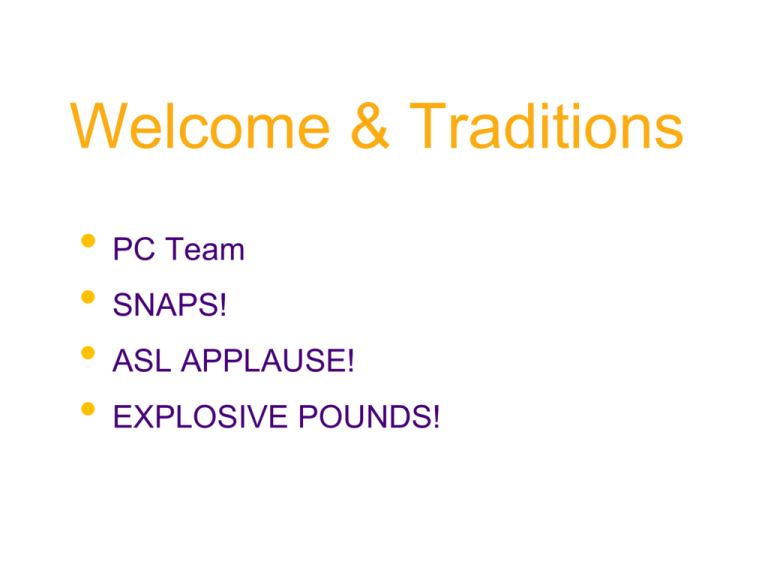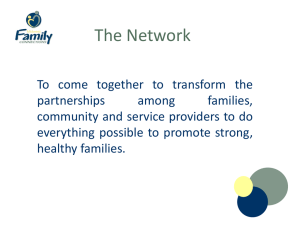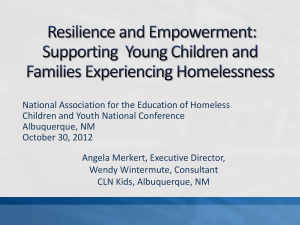Welcome & Traditions - NYU School of Medicine
advertisement

Welcome & Traditions • PC Team • SNAPS! • ASL APPLAUSE! • EXPLOSIVE POUNDS! Trauma and Resilience in Young Children Demy Kamboukos, PhD Assistant Professor of Population Health and Child and Adolescent Psychiatry Overview • Trauma and Toxic Stress in Childhood • • Consequences and Common Reactions to Trauma and Stress • • • Prevalence Rates Factors Influencing Reactions and Coping Resilience Strategies for School-Based Personnel & Mental Health Professionals Trauma • An emotional response (to an adverse or stressful event) often with long-lasting effects. Traumatic Events • • • • • • Community Violence Family Violence and Neglect Living Conditions Medical Interventions Loss and Death of Family or Friends Overexposure to Media Prevalence Rates • • • • • 68% of children are exposed to a traumatic event before the age of 16. 52.5% of 2-5 year olds have experienced a significant stressor 31% of children in NYC live in poverty Over the course of a year 1 in 5 children witness domestic and/or neighborhood violence About 5% of children and adolescents experience a crucial loss before the age of 15 Three Types of Stress Responses Positive Stress Response • • • • A physiological state that is brief and mild to moderate in magnitude Dealing with frustration, getting an immunization, anxiety associated with the first day at child care or preschool Growth-promoting element of normal development Provide important opportunities to observe, learn and practice healthy adaptive responses to adverse experiences Three Types of Stress Responses Tolerable Stress Response • Exposure to non-normative experiences that present a greater magnitude of adversity or threat • Natural disaster, act of terrorism, death of family member, serious illness Three Types of Stress Responses Toxic Stress Response • • • Child abuse or neglect, parental substance abuse, maternal depression Adverse Childhood Experiences Possible disruption of brain circuitry and other organ and metabolic systems during sensitive developmental periods. • Strong, frequent or prolonged activation of the body’s stress response systems in the absence of the buffering protection of a supportive adult relationship. Child Factors Family & Community Factors Parent Siblings Family & Parenting Family & Community Factors School & Teacher Resources Cultural Beliefs & Norms Nurturing Environements Communication & Cohesion Social Support Type of Trauma Common Reactions • Traumatic Symptoms: • • • Increased Arousal (Irritability, anger, nervousness, startle) Avoidance of thoughts, feelings, places, events Reactivity (tantrums, crying) Emotional Functioning: • • Mood swings, Sadness, Anxiety, Fear Worry about safety of loved ones or own well-being Behavioral Functioning: • • • Aggression Non-Compliance, oppositional and defiant behaviors Impulsiveness, risk taking Common Reactions • Cognitive Functioning: • • • Repetitive talk or thinking about the event Social Functioning: • • • • • Difficulties concentrating and remembering Social withdrawal Feeling “different” Separation anxiety, clinging to adults Conflicts Academic Functioning: • • Academic or learning problems Failure Common Reactions • Physical Functioning: • • • • • • Increased or decreased activity level Sleep problems, nightmares Increased or decreased appetite Bed wetting Somatic complaints Developmental Milestones: • • Delays Daily Living Skills Mental Health Consequences • About a third of children develop significant psychiatric difficulties and adverse effects on their development • • More than 20 million children are affected by PTSD Wide range of symptoms and reactions • Fluctuations in symptoms over time • Children are vulnerable into adulthood • Majority cope effectively Promoting Resilience • Caring and responsive adults who help children cope with stressors can mitigate the negative effects of the response to toxic stress. • The buffering protection of caring and responsive adults can prevent physiologic harm and long-term consequences for health and learning. • http://developingchild.harvard.edu/resource s/multimedia/videos/theory_of_change/ Resilience • A process of, capability for, or outcome of successful adaptation despite challenging or threatening circumstances (adversity, trauma, tragedy, threats or significant sources of stress) • Affected by individual and environmental factors, both determined by context • (Masten, Best, & Garmezy, 1990) Resilience • Children who do well in the face of adversity • Beliefs, feelings and thoughts that emerge with • adversity and stress Resilience can be enhanced or fostered by building on protective factors Resilience Associated with individual factors: • • • • • • Easy temperament Empathic, friendly, easy going High self-esteem Expressive Shows positive emotions Sense of control • • • • • Problem solving skills Goal-oriented Belief in just world Seeks out support Area of perceived competence valued by others Associated with environmental factors: • • • • • *Positive relationship with supportive adult Supportive, warm family environment Parents’ psychological functioning Parenting style Supportive, engaging school environment • • • • Positive role models Peer relations, friendships After-school activities, organized social groups Community service, volunteer work Strategies for School Personnel & Mental Health Professionals • • • • • • Identify Warning Signs Provide Information & Explanation Communicate Involve and Empower Be a Role Model Seek Help Identify Warning Signs • • • • Understand normative reactions • • • • Expect fluctuations in behavior and mood Expect questions and preoccupations Expect changes in academics, behaviors, emotions Expect regressive behaviors Know your student’s history Look for significant continued impairment Include parents in identification and evaluation Provide Information • • • Collaborate with parents about information shared and discussed Educate parents • Open, informed conversation about warning signs and consequences • Answer questions directly • Offer referrals and resources Provide information to children in developmentally-appropriate ways Communicate • • • • • Follow the child’s lead • Give a child space to talk • Avoid making assumptions Welcome discussions and questions Create activities that will give children opportunities to communicate (e.g., book report) Connect with the family • Be aware of changes & resources at home Model communication Empower • • • • Give choices when possible Listen to children’s opinions and thoughts Give children independence and permission to pursue their interests and hobbies Encourage children to become involved in the community, giving back, raising money Adults as Role Models • • • • • Children pick up on cues and feelings Remain calm Monitor Media Model and encourage open communication Model problem solving and coping skills Seek Support • • • • Ask for help Seek professional guidance Build on social networks Create a list of referrals Table Debrief ◌ What can you do (as an individual, site, community member) to address the trauma of the children with whom you work? ◌ In what way have traumatic events in children’s lives or your community impacted your work? ◌ How can we support each other as professionals in dealing with these issues? What’s Parenting Got To Do with It?: What's parenting got to do with it? The state of the evidence for investing in families Laurie Miller Brotman, Ph.D. Bezos Family Foundation Professor of Early Childhood Development Center for Early Childhood Health and Development Department of Population Health NYU Langone Medical Center a universal approach that brings together parents in the school community to create a sustainable network of effective and involved parents to help young children succeed family-centered, school-based intervention that is culturally-relevant and accessible to all families in high-need communities as their children enter school Diversity of children and families Primacy of parents and families ParentCorps Video https://www.youtube.com/watch?v=BVPHm VUeh3U Family Participation Trial • 88% of Pre-K student population participated Family Program (early evening 13 session group series) • 58% of families participated • • • Ranging across schools (44 - 75%) Increasing over the 4 years of implementation (50 - 65%) 39% received “full dose” (> 5 sessions) • • Ranging across schools (28 - 64%) Increasing over time (32 - 45%) Predictors of Family Program Participation • Participation was NOT predicted by risk status or the majority of demographic factors considered Brotman, L.M., Calzada, E., Kingston, S., Huang, K., Dawson-McClure, S.R., Kamboukos, D., Rosenfelt, A., Schwab, A., & Petkova, E. (2011). Promoting effective parenting practices and preventing conduct problems among ethnic minority families from low-income, urban communities. Child Development, 82(1), 258-276. Brotman, L. M., Dawson-McClure, S.R., Huang, K. Y., Theise, R., Kamboukos, D., Wang, J., Petkova, E., & Ogedegbe, G. (2012). Family intervention in early childhood and long-term obesity prevention among high risk minority youth. Pediatrics, 129, e621-e628. Brotman, L. M., Dawson-McClure, S.R., Calzada, E. J., Huang, K. Y., Kamboukos, D., Palamar, J., & Petkova, E. (2013). A cluster (school) RCT of ParentCorps: Impact on kindergarten academic achievement. Pediatrics, 131, e15211529. Dawson-McClure, S.R., Calzada, E.J., Huang, K.Y., Kamboukos, D., Rhule, D., Kolawole, B., Petkova, E., & Brotman, L.M. (2014). A population-level approach to promoting healthy child development and school success in low-income urban neighborhoods: Impact on parenting and child conduct problems. Prevention Science, Epub ahead of print. Dawson-McClure, S.R., Brotman, L.M., Theise, R., Palamar, J., Kamboukos, D., Barajas, G., & Calzada, E. (2014). Early childhood obesity prevention in low-income, urban communities. Journal of Prevention & Intervention in the Community,42 (2), 152-166. Table Debrief ◌ What are the challenges of interacting with a child who has difficulties with self-regulation? ◌ In what way is a child’s behavioral or emotional dysregulation challenging to a parent? Or a teacher? ◌ Are there specific policies or practices that you would like to see in your setting to engage and support families, especially those with children who have low self-regulation? ParentCorps and University Settlement: Partnering Together to Build Resilience in Children What's parenting got to do with it? Bukky Kolawole, PsyD Dana Rhule, PhD Katherine Rosenblatt, LCSW Center for Early Childhood Health and Development Mary Castillejos, LMSW, M.S. Ed. University Settlement Fill in the blank… The most important thing my parents did for me to help me deal with stress and adversity was: ___________________________ Goals for Today • Understand your experiences as it relates to building resilience • Provide you with some information about building resilience • Share our ParentCorps approach to building resilience • Share a University Settlement case example Your Value For Resilience • • • • What does a “resilient child” look like to you? What does a “resilient parent or family” look like to you? Why do you care? In terms of your work, what are your: • • strengths in this area? challenges? Building Resilience in Children To help, adults can: • • • • • • • • • • Maintain structure and routines Maintain rules and consequences Prepare children and anticipate changes Focus on open communication Focus on emotions and validate feelings Build positive experiences and memories through activities Build self concept and sense of self Build strong parent-child relationship Empower—give choices and independence whenever possible Seek out support Resilient Parent = Resilient Child • “Parents are the first environmental protective agents for development” (Masten, Best, & Garmezy, 1990) How to Build a Resilient Parent & Child • • • Connection Concrete Skills Confidence/Competence The Three C’s Connection Concrete Skills Confidence/ Competence Collaboration – Autonomy – Culture – Community – Evidence ParentCorps Beliefs and Values Inform Spirit Governs Specific Behaviors Non-Verbal &Verbal Timing Content • Approach to family engagement – – – – – • Flexible: “Come whenever you can, even if it means coming late” Repeated invitations: “We’re not giving up on you” Inclusive: “Your whole family is welcome to come” Direct: “What is your reason for coming? How will you make it back next week?” Fliers home, outreach at drop-off/pickup, phone calls, stickers on children Culturally-informed environment of value – – – Explicit focus on cultural values, norms and goals Partnerships between parents and teachers Collaborative and autonomy-supporting The Three C’s Connection Concrete Skills Confidence/ Competence Collaboration – Autonomy – Culture – Community – Evidence Connection – Parents • A process and an outcome of Parent Group • Support and empathy for struggles • Sharing about culture, history • Nonjudgmental, environment of value • Celebrate successes Connection – Children • • • • • • Sharing about culture, individual differences New friendships, time with friends Individual attention from teachers Parent-child interaction Support for struggles Celebrate successes, reaching goals The Three C’s Connection Concrete Skills Confidence/ Competence Collaboration – Autonomy – Culture – Community – Evidence Building Resilience in Children To help, adults can: • • • • • • • • • • Maintain structure and routines Maintain rules and consequences Prepare children and anticipate changes Focus on open communication Focus on emotions and validate feelings Build positive experiences and memories through activities Build self concept and sense of self Build strong parent-child relationship Empower—give choices and independence whenever possible Seek out support Concrete Skills – Parents • Specific skills to build character, coping, sense of control, & contribution • • • • • • Routines and responsibilities (predictability, consistency, sense of control, contribution) FUN skills (building the relationship, empowering child) FEEL technique (emotional responsiveness and building problem solving and expressiveness) Positive reinforcement (self-esteem, goal-oriented) Limit setting (maintain structure, belief in just world) Self-care Skills Follow the child’s lead! You do what they do! Say what you see and hear! • https://www.youtube.com/watch?v=F1gn XBNJuPo Positive Reinforcement Limit Setting Practice Self-care Concrete Skills – Children • Specific skills to build character, coping, sense of control, & contribution • • • • • Friendship skills (helping, sharing)—builds connection, competencies, character, involvement Dealing with feelings—coping skills, ability to show positive feelings Self-esteem, Individual difference Problem solving skills Mindfulness—CBT strategies to manage thoughts, feelings, and body experiences The Three C’s Connection Concrete Skills Confidence/ Competence Collaboration – Autonomy – Culture – Community – Evidence Confidence/Competence • Practice of skills • Parent-child activity • Honest sharing about abilities and experiences • Barriers and troubleshooting • What would you say to a family member? • Individualizing • Graduation The Power of EMPATHY http://brenebrown.com/2013/12/10/rsabear/ Thoughts? Reactions?? Case presentation • • • Isolation Confusion Anxiety Case presentation • • • Isolation CONNECTION Confusion CONCRETE SKILLS Anxiety CONFIDENCE / COMPETENCE Table Debrief ◌ What’s one thing you are taking away in terms of building resilience for parents and children? ◌ How does the video about empathy apply to your work with children and families? ◌What other thoughts did you have regarding the specific family presented?









